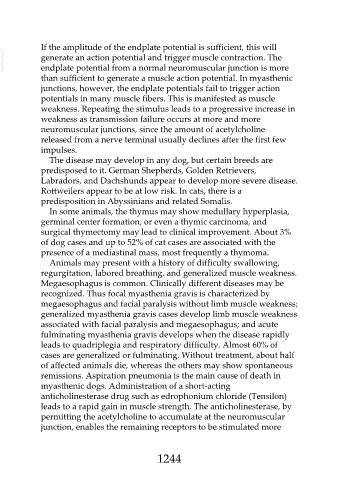Page 1244 - Veterinary Immunology, 10th Edition
P. 1244
If the amplitude of the endplate potential is sufficient, this will
VetBooks.ir generate an action potential and trigger muscle contraction. The
endplate potential from a normal neuromuscular junction is more
than sufficient to generate a muscle action potential. In myasthenic
junctions, however, the endplate potentials fail to trigger action
potentials in many muscle fibers. This is manifested as muscle
weakness. Repeating the stimulus leads to a progressive increase in
weakness as transmission failure occurs at more and more
neuromuscular junctions, since the amount of acetylcholine
released from a nerve terminal usually declines after the first few
impulses.
The disease may develop in any dog, but certain breeds are
predisposed to it. German Shepherds, Golden Retrievers,
Labradors, and Dachshunds appear to develop more severe disease.
Rottweilers appear to be at low risk. In cats, there is a
predisposition in Abyssinians and related Somalis.
In some animals, the thymus may show medullary hyperplasia,
germinal center formation, or even a thymic carcinoma, and
surgical thymectomy may lead to clinical improvement. About 3%
of dog cases and up to 52% of cat cases are associated with the
presence of a mediastinal mass, most frequently a thymoma.
Animals may present with a history of difficulty swallowing,
regurgitation, labored breathing, and generalized muscle weakness.
Megaesophagus is common. Clinically different diseases may be
recognized. Thus focal myasthenia gravis is characterized by
megaesophagus and facial paralysis without limb muscle weakness;
generalized myasthenia gravis cases develop limb muscle weakness
associated with facial paralysis and megaesophagus; and acute
fulminating myasthenia gravis develops when the disease rapidly
leads to quadriplegia and respiratory difficulty. Almost 60% of
cases are generalized or fulminating. Without treatment, about half
of affected animals die, whereas the others may show spontaneous
remissions. Aspiration pneumonia is the main cause of death in
myasthenic dogs. Administration of a short-acting
anticholinesterase drug such as edrophonium chloride (Tensilon)
leads to a rapid gain in muscle strength. The anticholinesterase, by
permitting the acetylcholine to accumulate at the neuromuscular
junction, enables the remaining receptors to be stimulated more
1244

